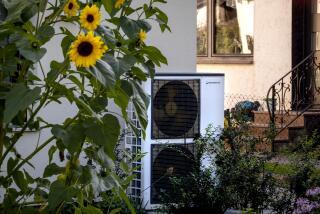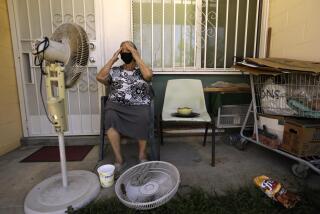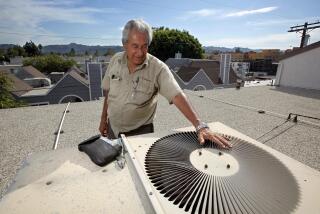Solar Attic Fans Keep You Cool
- Share via
Question: I have a few attic vents, but I can still feel the sun’s heat radiating from the ceiling during the afternoon. It is uncomfortably warm. What do you think of installing more standard vents or new solar vents?
Answer: People are often surprised how much discomfort and how many high utility bills result from heat blasting down from a hot roof.
Attic floor insulation is relatively ineffective at blocking radiant heat from a 150-degree roof. Installing a solar attic vent fan helped cool my second-floor bedrooms.
The best method to block this heat is a combination of adequate attic ventilation and low-emissivity, reflective foil stapled under the roof rafters. The ventilation helps reduce the roof temperature caused by the intense sun, and the foil shields your ceiling from the radiant heat transfer.
Solar-powered attic vent fans are an ideal fit for keeping your attic cooler in the summer, and they operate for free from the sun’s energy. A small solar cell panel converts the sun’s energy into electricity. As the sun’s rays get hotter in the afternoon, the vent fan automatically runs faster.
Attic ventilation is also needed in the winter to remove moist air that leaks up from the living areas. If the attic is not well vented, this moisture in the air can condense and drip down on the insulation. Wet insulation is not only ineffective, but it can actually damage the attic lumber.
Solar-powered vent fans range in size from mini 4-inch-diameter models to the more typical 12-to 16-inch sizes. The two basic designs of solar fans are self-contained (integral) and remote. The self-contained models have the solar cell panel built into the top of the fan housing. These models are excellent for a roof with a southern exposure.
For non-southern roof exposures, or shade problems, use a remote design with a separate solar cell panel and a fan. With up to a 20-foot safe, low-voltage wire, you can locate the panel to directly face the sun for maximum electricity output. You can also install an on/off switch if you wish.
Since there is no electrical wiring, installing one or two solar fans is a simple do-it-yourself project. Remove a few shingles and saw a round hole through the roof. Nail the fan in place and replace the shingles.
Natural attic ventilation is also an option, but you will have to install many more roof vents or a ridge vent along the entire length of the roof peak. Installing turbine vents instead can increase the amount of natural ventilation with fewer vents required. A unique electric-powered internal ridge vent is still another option.
Write for (or instantly download at https://www.dulley.com) Update Bulletin No. 657, a buyer’s guide of 11 solar-powered attic vent and turbine fans listing air flow ratings, watts, sizes, features, prices, and a sizing chart. Include $3 and a business-size, self-addressed, stamped envelope and mail to James Dulley, Los Angeles Times, 6906 Royalgreen Drive, Cincinnati, OH 45244.
Instead of Shower-Sauna, Try Steam Generator
Q: We are building a new house, but it is not very big.I am trying to find some way to build a combination shower and sauna unit. Is there such a thing, or can I make one?
A: That combination would not work very well. Saunas operate at very high temperatures and, therefore, must be made of wood so that you don’t get burnt. This would not be consistent with a typical shower.
You might consider a steam generator instead for your shower. There are many small models available specifically for your application. Install airtight shower doors to avoid losing heat and moisture to the rest of the house.
Methodically Check Air Duct for Blockage
Q: We don’t seem to get much cooled or heated air out of the register in one of the bedrooms. Is there any way that someone can determine if there is some kind of blockage in that bedroom duct?
A: First you should check the damper in that duct near the blower unit. It might be closed, blocking the air flow. Don’t rely on the position of the handle. Test air flow in both extreme positions.
After other testing, if you still suspect a blockage, some heating or duct cleaning contractors have small duct cams that they can feed into the duct to inspect it.
Calculate Heat Loss Before Replacing Furnace
Q: With winter approaching in several months, I am giving my heating system some thought. If I replace the furnace, I am wondering whether a heat pump or another gas furnace is better.
A: This is a very difficult question to answer because which is best depends on very many variables: the relative price of gas and electricity in your area, efficiency of the units, efficiency of your house, your budget, etc.
The only way to make an accurate determination is to have a heating contractor do a computerized heat loss calculation of your house. After this, he must do payback analyses on several different models of both types of heating systems.
More to Read
Sign up for Essential California
The most important California stories and recommendations in your inbox every morning.
You may occasionally receive promotional content from the Los Angeles Times.






